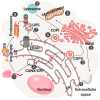Control of Protein Homeostasis in the Early Secretory Pathway: Current Status and Challenges
- PMID: 31671908
- PMCID: PMC6912474
- DOI: 10.3390/cells8111347
Control of Protein Homeostasis in the Early Secretory Pathway: Current Status and Challenges
Abstract
: Discrimination between properly folded proteins and those that do not reach this state is necessary for cells to achieve functionality. Eukaryotic cells have evolved several mechanisms to ensure secretory protein quality control, which allows efficiency and fidelity in protein production. Among the actors involved in such process, both endoplasmic reticulum (ER) and the Golgi complex play prominent roles in protein synthesis, biogenesis and secretion. ER and Golgi functions ensure that only properly folded proteins are allowed to flow through the secretory pathway while improperly folded proteins have to be eliminated to not impinge on cellular functions. Thus, complex quality control and degradation machineries are crucial to prevent the toxic accumulation of improperly folded proteins. However, in some instances, improperly folded proteins can escape the quality control systems thereby contributing to several human diseases. Herein, we summarize how the early secretory pathways copes with the accumulation of improperly folded proteins, and how insufficient handling can cause the development of several human diseases. Finally, we detail the genetic and pharmacologic approaches that could be used as potential therapeutic tools to treat these diseases.
Keywords: EGAD; ER stress; ERAD; Golgi stress; protein quality control.
Conflict of interest statement
Abbreviations
Figures




Similar articles
-
Protein folding state-dependent sorting at the Golgi apparatus.Mol Biol Cell. 2019 Aug 1;30(17):2296-2308. doi: 10.1091/mbc.E19-01-0069. Epub 2019 Jun 5. Mol Biol Cell. 2019. PMID: 31166830 Free PMC article.
-
Blocking variant surface glycoprotein synthesis alters endoplasmic reticulum exit sites/Golgi homeostasis in Trypanosoma brucei.Traffic. 2018 Jun;19(6):391-405. doi: 10.1111/tra.12561. Epub 2018 Apr 6. Traffic. 2018. PMID: 29533496 Free PMC article.
-
Pharmacologic Approaches for Adapting Proteostasis in the Secretory Pathway to Ameliorate Protein Conformational Diseases.Cold Spring Harb Perspect Biol. 2020 May 1;12(5):a034108. doi: 10.1101/cshperspect.a034108. Cold Spring Harb Perspect Biol. 2020. PMID: 31088828 Free PMC article. Review.
-
Protein Quality Control in the Endoplasmic Reticulum.Protein J. 2019 Jun;38(3):317-329. doi: 10.1007/s10930-019-09831-w. Protein J. 2019. PMID: 31004255 Free PMC article. Review.
-
How Is the Fidelity of Proteins Ensured in Terms of Both Quality and Quantity at the Endoplasmic Reticulum? Mechanistic Insights into E3 Ubiquitin Ligases.Int J Mol Sci. 2021 Feb 19;22(4):2078. doi: 10.3390/ijms22042078. Int J Mol Sci. 2021. PMID: 33669844 Free PMC article. Review.
Cited by
-
An ERAD-independent role for rhomboid pseudoprotease Dfm1 in mediating sphingolipid homeostasis.EMBO J. 2023 Feb 15;42(4):e112275. doi: 10.15252/embj.2022112275. Epub 2022 Nov 9. EMBO J. 2023. PMID: 36350249 Free PMC article.
-
Consensus guidelines for the definition, detection and interpretation of immunogenic cell death.J Immunother Cancer. 2020 Mar;8(1):e000337. doi: 10.1136/jitc-2019-000337. J Immunother Cancer. 2020. PMID: 32209603 Free PMC article. Review.
-
Pgant4 and Tango1 Mediate Anoxia and Reoxygenation Injury.Neurosci Bull. 2020 Dec;36(12):1552-1557. doi: 10.1007/s12264-020-00562-y. Epub 2020 Aug 16. Neurosci Bull. 2020. PMID: 32803622 Free PMC article. No abstract available.
-
Unconventional Protein Secretion in Brain Tumors Biology: Enlightening the Mechanisms for Tumor Survival and Progression.Front Cell Dev Biol. 2022 Jun 15;10:907423. doi: 10.3389/fcell.2022.907423. eCollection 2022. Front Cell Dev Biol. 2022. PMID: 35784465 Free PMC article. Review.
-
The Delta-Opioid Receptor; a Target for the Treatment of Pain.Front Mol Neurosci. 2020 May 5;13:52. doi: 10.3389/fnmol.2020.00052. eCollection 2020. Front Mol Neurosci. 2020. PMID: 32431594 Free PMC article. Review.
References
Publication types
MeSH terms
Substances
LinkOut - more resources
Full Text Sources

